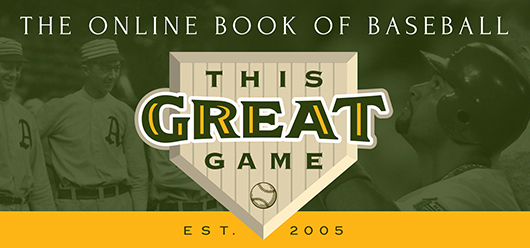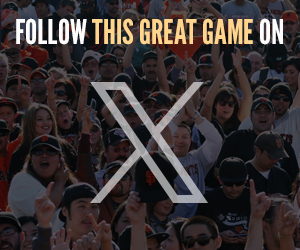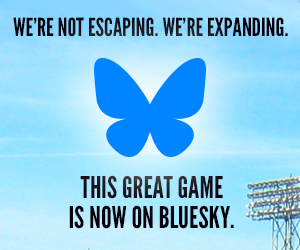The Yearly Reader
Leaders and Honors, 2024
Our list of baseball’s top 10 hitters and pitchers in both the American League and National League for the 2024 baseball season, as well as the awards and honors given to the game’s top achievers of the year.
The National League’s Top 10 Hitters, 2024
Bold type in brick red indicates league leader.
1. Shohei Ohtani, Los Angeles
Key Numbers: .310 batting average, 134 runs, 197 hits, 38 doubles, 7 triples, 54 home runs, 130 RBIs, 81 walks, 59 stolen bases, .390 on-base percentage, .646 slugging percentage, 1.036 OPS, 411 total bases.
The unanimous NL MVP’s 50th home run—which made him the first major leaguer to homer and steal 50 times each in the same season—also set a Dodgers franchise record.
2. Francisco Lindor, New York
Key Numbers: .273 batting average, 107 runs, 39 doubles, 33 home runs, 91 RBIs, 12 hit-by-pitches, 29 stolen bases.
The league’s second most valuable guy, per the voters, certainly proved clutch at key moments late in the year; his ninth-inning homer in the season’s penultimate game put the Mets in the playoffs, while his grand slam in the NLDS clincher provided New York with all of its runs to put away divisional rival Philadelphia.
3. Kyle Schwarber, Philadelphia
Key Numbers: .248 batting average, 110 runs, 38 home runs, 104 RBIs, 106 walks, 197 strikeouts.
Fifteen of Schwarber’s 38 homers occurred leading off the game, setting a major league mark; after going all or nothing the previous two seasons, he eased on the power, allowing him to increase his batting average while slightly reducing his strikeout totals.
4. Ketel Marte, Arizona
Key Numbers: .292 batting average, 93 runs, 36 home runs, 95 RBIs.
In an up-and-down career, Marte hit peak while landing his second starting All-Star assignment at second base.
5. Marcell Ozuna, Atlanta
Key Numbers: 162 games, .302 batting average, 96 runs, 183 hits, 31 doubles, 39 home runs, 104 RBIs, 74 walks, 170 strikeouts, 23 grounded into double plays.
While every other member of the Braves’ potent lineup regressed or broke down, Ozuna excelled—though his chance to collect 40+ homers for a second straight year failed as he went deep just twice over his final 37 games.
6. Elly De La Cruz, Cincinnati
Key Numbers: .259 batting average, 105 runs, 36 doubles, 10 triples, 25 home runs, 76 RBIs, 67 stolen bases, 16 caught stealing, 218 strikeouts.
The second-year shortstop looked to be a superstar-level work in progress; no previous player amassed 100 extra-base hits and steals each in fewer games to start a career.
7. Mookie Betts, Los Angeles
Key Numbers: 116 games, .289 batting average, 75 runs, 24 doubles, 5 triples, 19 home runs, 75 RBIs, 16 stolen bases, 61 walks.
Betts’ fractured hand caused him to miss two months—and the Dodgers, curiously, could only manage to play slightly-better-than-.500 ball (25-20) without him.
8. William Contreras, Milwaukee
Key Numbers: .281 batting average, 99 runs, 37 doubles, 23 home runs, 92 RBIs, 78 walks.
The majors’ best-hitting catcher clearly showed he was more than just Willson Contreras’ kid brother.
9. Willy Adames, Milwaukee
Key Numbers: 161 games, .251 batting average, 93 runs, 33 doubles, 32 home runs, 112 RBIs, 21 stolen bases, 74 walks, 173 strikeouts.
In his last of three-plus satisfying years at Milwaukee, Adames hit 13 three-run homers to tie Ken Griffey Jr,’s 1996 MLB mark.
10. Corbin Carroll, Arizona
Key Numbers: .231 batting average, 121 runs, 22 doubles, 14 triples, 22 home runs, 74 RBIs, 35 stolen bases, 73 walks.
It had been 137 years since anyone scored as many runs on a worse batting average, as the reigning NL Rookie of the Year still mattered despite a slow start.
The American League’s Top 10 Hitters, 2024
1. Aaron Judge, New York
Key Numbers: .322 batting average, 122 runs, 180 hits, 36 doubles, 58 home runs, 144 RBIs, 133 walks, 20 intentional walks, 171 strikeouts, .458 on-base percentage, .701 slugging percentage, 1.159 OPS, 22 grounded into double plays.
In winning his second AL MVP, Judge became the fifth major leaguer with three seasons of 50+ home runs; his 18 first-inning bombs tied Alex Rodriguez’s 2001 record.
2. Bobby Witt Jr., Kansas City
Key Numbers: 161 games, .332 batting average, 125 runs, 211 hits, 45 doubles, 11 triples, 32 home runs, 109 RBIs, 31 stolen bases.
The Royals clearly got their money’s worth in the first year of Witt’s $288 million contract; only three other major leaguers had collected 30 homers, 30 steals and 10 triples in a season.
3. Juan Soto, New York
Key Numbers: .288 batting average, 128 runs, 31 doubles, 41 home runs, 109 RBIs, 129 walks.
The one-year Yankee was more dangerous than usual because, with Judge always waiting on deck, he got better pitches to hit—and yet he still walked 129 times. Along with Judge, Soto became part of the third Yankee duo (after Babe Ruth/Lou Gehrig and Mickey Mantle/Roger Maris) with 40+ homers each in the same year.
4. Jose Ramirez, Cleveland
Key Numbers: .279 batting average, 114 runs, 173 hits, 39 doubles, 39 home runs, 118 RBIs, 41 stolen bases.
Rain in the season finale deprived Ramirez of the chance to become the year’s second player (after Shohei Ohtani) to achieve 40-40 status.
5. Gunnar Henderson, Baltimore
Key Numbers: .281 batting average, 118 runs, 177 hits, 31 doubles, 7 triples, 37 home runs, 92 RBIs, 21 stolen bases, 78 walks.
The 2023 AL Rookie of the Year only got better; at age 22, he became the youngest-ever player with 10 home runs before the end of April.
6. Vladimir Guerrero Jr., Toronto
Key Numbers: .323 batting average, 98 runs, 199 hits, 44 doubles, 30 home runs, 103 RBIs, 72 walks.
Few people were hotter after the All-Star Break as Guerrero led all major leaguers with a second-half .376 batting average—but he went hitless in his last six at-bats, thus failing to reach 200 hits for the first time.
7. Brent Rooker, Oakland
Key Numbers: .293 batting average, 39 home runs, 112 RBIs, 11 stolen bases, 177 strikeouts.
Goodbye Coliseum, hello Sacramento; the fast-evolving DH was happy to no longer play at the aging Oakland stadium, where he hit just 15 of his 39 homers.
8. Yordan Alvarez, Houston
Key Numbers: .308 batting average, 88 runs, 170 hits, 34 doubles, 35 home runs, 86 RBIs, 69 walks.
The Astros’ boomer became the second player in franchise history—and the second in as many years (after Jose Altuve)—to have both a three-homer game and cycle in the same season.
9. Jarren Duran, Boston
Key Numbers: .285 batting average, 671 at-bats, 111 runs, 191 hits, 48 doubles, 14 triples, 21 home runs, 75 RBIs, 34 stolen bases.
In a scintillating breakout performance, Duran became the first MLB player since Lou Brock in 1968 to lead the majors in both doubles and triples. He missed only two games, both via suspension after verbally abusing a Fenway Park fan with both F-words within earshot of TV crowd mics.
10. Rafael Devers, Boston
Key Numbers: .272 batting average, 87 runs, 34 doubles, 5 triples, 28 home runs, 83 RBIs, 67 walks.
Boston’s slugging mainstay homered in six consecutive games, establishing a Red Sox record.
The National League’s Top 10 Pitchers, 2024
1. Chris Sale, Atlanta
Key Numbers: 2.38 ERA, 18 wins, 3 losses, .857 win percentage, 177.2 innings, 39 walks, 225 strikeouts.
Given up by Boston, Sale had the kind of season the Red Sox and their fans could only dream of during five previous, torturous, injury-marred seasons.
2. Zack Wheeler, Philadelphia
Key Numbers: 2.57 ERA, 16 wins, 7 losses, .696 win percentage, 32 starts, 200 innings, 224 strikeouts, 0.96 WHIP, .192 batting average against.
Blessed with a three-year extension paying him over $40 million a season, Wheeler easily led the majors with 26 quality starts—yet 12 of them did not earn him a win.
3. Ryan Helsley, St. Louis
Key Numbers: 2.04 ERA, 7 wins, 4 losses, 65 appearances, 49 saves, 4 blown saves, 66.1 innings.
Without a once-again healthy Helsley—who set a franchise mark for saves—the Cardinals might have finished in last place for a second straight year. Of his 49 closeouts, 23 were in 1-2-3 fashion.
4. Paul Skenes, Pittsburgh
Key Numbers: 1.96 ERA, 11 wins, 3 losses, .786 win percentage, 23 starts, 133 innings, 32 walks, 170 strikeouts, 0.95 WHIP.
A startling debut for baseball’s top pitching prospect, the hard-throwing Skenes was twice removed from no-hit outings of six or more innings, and only once gave up more than three runs—and that was against the Dodgers, who notched four.
5. Raisel Iglesias, Atlanta
Key Numbers: 1.95 ERA, 6 wins, 2 losses, 66 appearances, 34 saves, 69.1 innings.
Perhaps the most effective campaign for the Cuban-born veteran closer included a midseason streak of 35.1 straight innings without allowing an earned run—and 13 straight without allowing a hit.
6. Logan Webb, San Francisco
Key Numbers: 3.47 ERA, 13 wins, 10 losses, 33 starts, 1 shutout, 204.2 innings.
The presence of the current-day workhorse was all the more pivotal given that the Giants as a team had the fewest innings thrown by starting pitchers in the NL.
7. Shota Imanaga, Chicago
Key Numbers: 2.91 ERA, 15 wins, 3 losses, .833 win percentage, 173.1 innings, 28 walks, 174 strikeouts.
Everyone was focused on the arrival of Yoshinobu Yamamoto in Los Angeles, but Imanaga emerged as the best of the Japanese imports; his 0.84 ERA was the lowest ever recorded by a major league pitcher over his first nine career starts.
8. Max Fried, Atlanta
Key Numbers: 3.25 ERA, 11 wins, 10 losses, 2 complete games, 1 shutout, 174.1 innings.
In his last year at Atlanta before being signed by the Yankees, Fried was one of three pitchers with multiple complete games; he came within an out of a third; and twice was removed after the sixth inning or later allowing no hits.
9. Robert Suarez, San Diego
Key Numbers: 2.77 ERA, 9 wins, 3 losses, 65 appearances, 36 saves, 65 innings.
In his third major league season after spending the bulk of his pro baseball time in Mexico and Japan, the 33-year-old Suarez took over closing roles for the departed Josh Hader and earned himself an All-Star roster spot.
10. Dylan Cease, San Diego
Key Numbers: 3.47 ERA, 14 wins, 11 losses, 33 starts, 1 shutout, 189.1 innings, 224 strikeouts, 12 wild pitches.
Traded from, or more aptly, having escaped from, the coming disaster that would be the 41-121 White Sox, Cease had five starts allowing one hit, and another allowing none—resulting in the Padres’ second-ever no-hitter, July 25 at Washington.
The American League’s Top 10 Pitchers, 2024
1. Tarik Skubal, Detroit
Key Numbers: 2.39 ERA, 18 wins, 4 losses, .818 win percentage, 192 innings, 35 walks, 228 strikeouts, 0.92 WHIP, .558 OPS against.
The gradual maturation of Skubal was complete as the southpaw won the triple crown of pitching—and helped inspire an anonymous Tigers ballclub to rally over the final month-plus to its first postseason appearance in a decade.
2. Framber Valdez, Houston
Key Numbers: 2.91 ERA, 15 wins, 7 losses, .682 win percentage, 176.1 innings.
Valdez nearly had a second straight season with a no-hitter, but was denied on August 6 when the Rangers’ Corey Seager launched a two-run, two-out homer in the ninth at Houston.
3. Seth Lugo, Kansas City
Key Numbers: 3.00 ERA, 16 wins, 9 losses, .640 win percentage, 33 starts, 206.2 innings.
The veteran reliever, converted the year before into a starter, thrived in his first season at Kansas City—finishing second in the majors in innings pitched, and second behind Skubal in the AL Cy Young vote.
4. Emmanuel Clase, Cleveland
Key Numbers: 0.61 ERA, 4 wins, 2 losses, 74 appearances, 47 saves, 3 blown saves, 74.1 innings, 39 hits allowed.
The game’s most in-demand closer—appearing over 70 times for the fourth straight year—was also the best, breaking Jose Mesa’s 1995 franchise saves record. He proved far less automatic in the playoffs, allowing three more earned runs (eight) than during the entire regular season.
5. Bryce Miller, Seattle
Key Numbers: 2.94 ERA, 12 wins, 8 losses, 180.1 innings, 0.97 WHIP.
The second-year right-hander was arguably the best hurler on a strong Seattle starting rotation; he was especially sharp at T-Mobile Park, posting a 1.96 ERA in 16 starts.
6. Kirby Yates, Texas
Key Numbers: 1.17 ERA, 7 wins, 2 losses, 61 appearances, 33 saves, 1 blown save, 61.2 innings, 23 hits allowed, 85 strikeouts.
On his sixth major league team, the 37-year-old native from Kauai may have produced the season’s most under-the-radar success; he certainly stood out from a Texas bullpen that otherwise produced a poor 4.78 ERA.
7. Tanner Houck, Boston
Key Numbers: 3.12 ERA, 9 wins, 10 losses, 1 shutout, 178.2 innings, 16 hit-by-pitches.
The year’s hard-luck award went to Houck, who had the lowest ERA among qualifying pitchers with a below-.500 record.
8. Josh Hader, Houston
Key Numbers: 3.80 ERA, 8 wins, 8 losses, 62 appearances, 34 saves, 71 innings, 43 hits allowed, 105 strikeouts.
The first-year Astro settled into star form after a rough start, blowing only four save opportunities on the year.
9. Corbin Burnes, Baltimore
Key Numbers: 3.30 ERA, 13 wins, 9 losses, 152.2 innings, 26 starts.
Traded from the Brewers as free agency loomed, Burnes set a career high in wins and was rewarded with his first All-Star starting assignment.
10. Cole Ragans, Kansas City
Key Numbers: 3.14 ERA, 11 wins, 9 losses, 186.1 innings, 223 strikeouts, 11 wild pitches.
Turning heads in a second-half breakout the year before, Ragans proved he could maintain quality pitching over a full season; he finished a close second to Skubal in the AL strikeout race.





